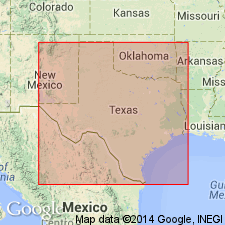
- Usage in publication:
-
- Caballos novaculite
- Modifications:
-
- Original reference
- Dominant lithology:
-
- Novaculite
- Chert
- AAPG geologic province:
-
- Permian basin
Summary:
Pg. 39. Caballos novaculite. Upper part massive bedded, ripple-marked, and much fractured white novaculite, 50 feet thick; lower part 40 feet of rather thin-bedded, light-brown chert with some layers of white novaculite. Occurs in Marathon region. Named by Baker. E.O. Ulrich regards it as of Oriskany age. Unconformably underlies Santiago chert and unconformably overlies Maravillas chert.
[Named from Horse (Caballos) Mountain, Brewster Co., west-central TX.]
Source: US geologic names lexicon (USGS Bull. 896, p. 308).
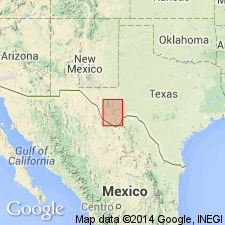
- Usage in publication:
-
- Caballos novaculite
- Modifications:
-
- Redefined
- AAPG geologic province:
-
- Permian basin
Summary:
Pg. 93. Caballos novaculite redefined to include what were originally called Caballos novaculite and Santiago chert. Later work by senior author appears to indicate that they are really one formation, two members of both the original Caballos and Santiago being included in the section in some localities. It is now thought that in the localities first examined erosion has removed the upper novaculite and upper predominantly green chert. But there is possibility of duplication of beds by shearing or thrusting. Should this finally prove to be the case in the region where the section exhibits two members, both of the white novaculite and the banded, vari-colored chert in the same succession, the name Santiago may be reapplied to the latter.
Type locality: Caballos Mountain, the entire north face of which is made up of white Caballos novaculite.
Source: US geologic names lexicon (USGS Bull. 896, p. 308).
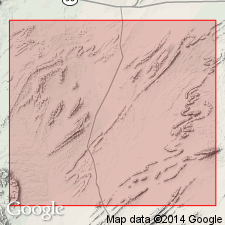
- Usage in publication:
-
- Caballos novaculite*
- Modifications:
-
- Overview
- AAPG geologic province:
-
- Permian basin
Summary:
Pg. 1078. The type Caballos of [Udden and others] 1916 publication comprised lower chert member, lower novaculite member, middle chert member, and upper novaculite member. The type "Santiago" of [Udden and others] 1916 publication consisted of middle and upper chert members combined, with upper novaculite member nearly absent between them. Because of overlapping of typical section, and stratigraphic unity of whole series, writer supports Baker and Bowman's [1917] decision to abandon "Santiago". Age is Devonian(?) (Oriskany?).
Source: US geologic names lexicon (USGS Bull. 896, p. 308).
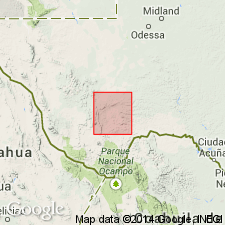
- Usage in publication:
-
- Caballos novaculite*
- Modifications:
-
- Revised
- AAPG geologic province:
-
- Permian basin
Summary:
Pg. 47-55, pls. 23, 24. Divided into five members (ascending) : lower chert; lower novaciilite; middle chert; upper novaculite; upper chert. Name Santiago chert, which had been applied to three upper memhers, abandoned. Thickness 200 to 600 feet. Overlies Maravillas chert; underlies Tesnus formation.
Source: US geologic names lexicon (USGS Bull. 1200, p. 565).
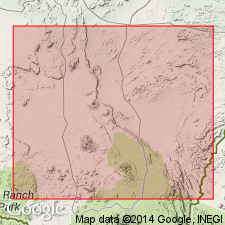
- Usage in publication:
-
- Caballos novaculite*
- Modifications:
-
- Revised
- AAPG geologic province:
-
- Permian basin
Summary:
King's (1937) lower two members of Caballos form one genetic unit and upper three members from another genetic unit; proposed here to revive original terminology of Udden, Baker, and Bose [1916] and recognize two distinct formations. Name Caballos is restricted to lower formation which includes lower chert member and lower novaculite member as described by King, and term Santiago chert revived and applied to upper three members.
Source: US geologic names lexicon (USGS Bull. 1200, p. 565).
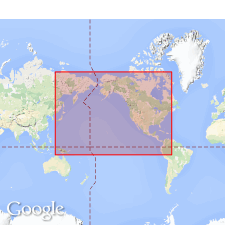
- Usage in publication:
-
- Caballos Novaculite*
- Modifications:
-
- Overview
- AAPG geologic province:
-
- Permian basin
Summary:
The USGS currently [ca. 1966] designates the age of the Caballos Novaculite as Devonian and Mississippian.
Source: US geologic names lexicon (USGS Bull. 1200, p. 565).
For more information, please contact Nancy Stamm, Geologic Names Committee Secretary.
Asterisk (*) indicates published by U.S. Geological Survey authors.
"No current usage" (†) implies that a name has been abandoned or has fallen into disuse. Former usage and, if known, replacement name given in parentheses ( ).
Slash (/) indicates name conflicts with nomenclatural guidelines (CSN, 1933; ACSN, 1961, 1970; NACSN, 1983, 2005, 2021). May be explained within brackets ([ ]).

